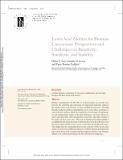Lewis Acid Zeolites for Biomass Conversion: Perspectives and Challenges on Reactivity, Synthesis, and Stability
Author(s)
Luo, Helen Y; Lewis, Jennifer Danielle; Roman, Yuriy
DownloadLewis acid zeolites.pdf (1.711Mb)
OPEN_ACCESS_POLICY
Open Access Policy
Creative Commons Attribution-Noncommercial-Share Alike
Terms of use
Metadata
Show full item recordAbstract
Zeolites containing Sn, Ti, Zr, Hf, Nb, or Ta heteroatoms are versatile catalysts for the activation and conversion of oxygenated molecules owing to the unique Lewis acid character of their tetrahedral metal sites. Through fluoride-mediated synthesis, hydrophobic Lewis acid zeolites can behave as water-tolerant catalysts, which has resulted in a recent surge of experimental and computational studies in the field of biomass conversion. However, many open questions still surround these materials, especially relating to the nature of their active sites. This lack of fundamental understanding is exemplified by the many dissonant results that have been described in recent literature reports. In this review, we use a molecular-based approach to provide insight into the relationship between the structure of the metal center and its reactivity toward different substrates, with the ultimate goal of providing a robust framework to understand the properties that have the strongest influence on catalytic performance for the conversion of oxygenates.
Date issued
2016-04Department
Massachusetts Institute of Technology. Department of Chemical EngineeringJournal
Annual Review of Chemical and Biomolecular Engineering
Publisher
Annual Reviews
Citation
Luo, Helen Y.; Lewis, Jennifer D. and Román-Leshkov, Yuriy. “Lewis Acid Zeolites for Biomass Conversion: Perspectives and Challenges on Reactivity, Synthesis, and Stability.” Annual Review of Chemical and Biomolecular Engineering 7, no. 1 (June 2016): 663–692 © 2016 Annual Reviews
Version: Author's final manuscript
ISSN
1947-5438
1947-5446